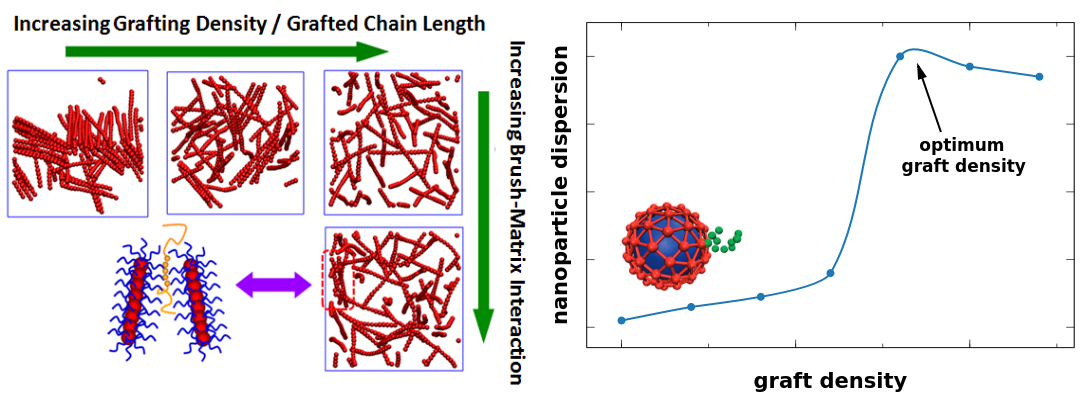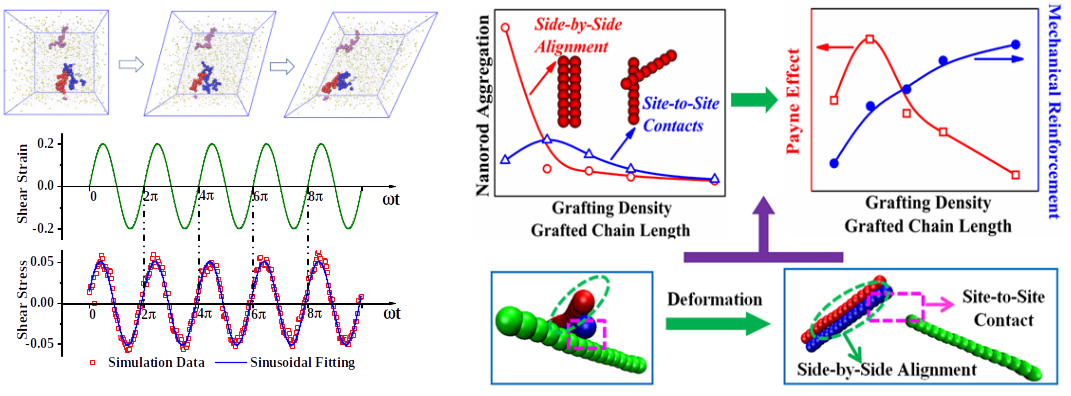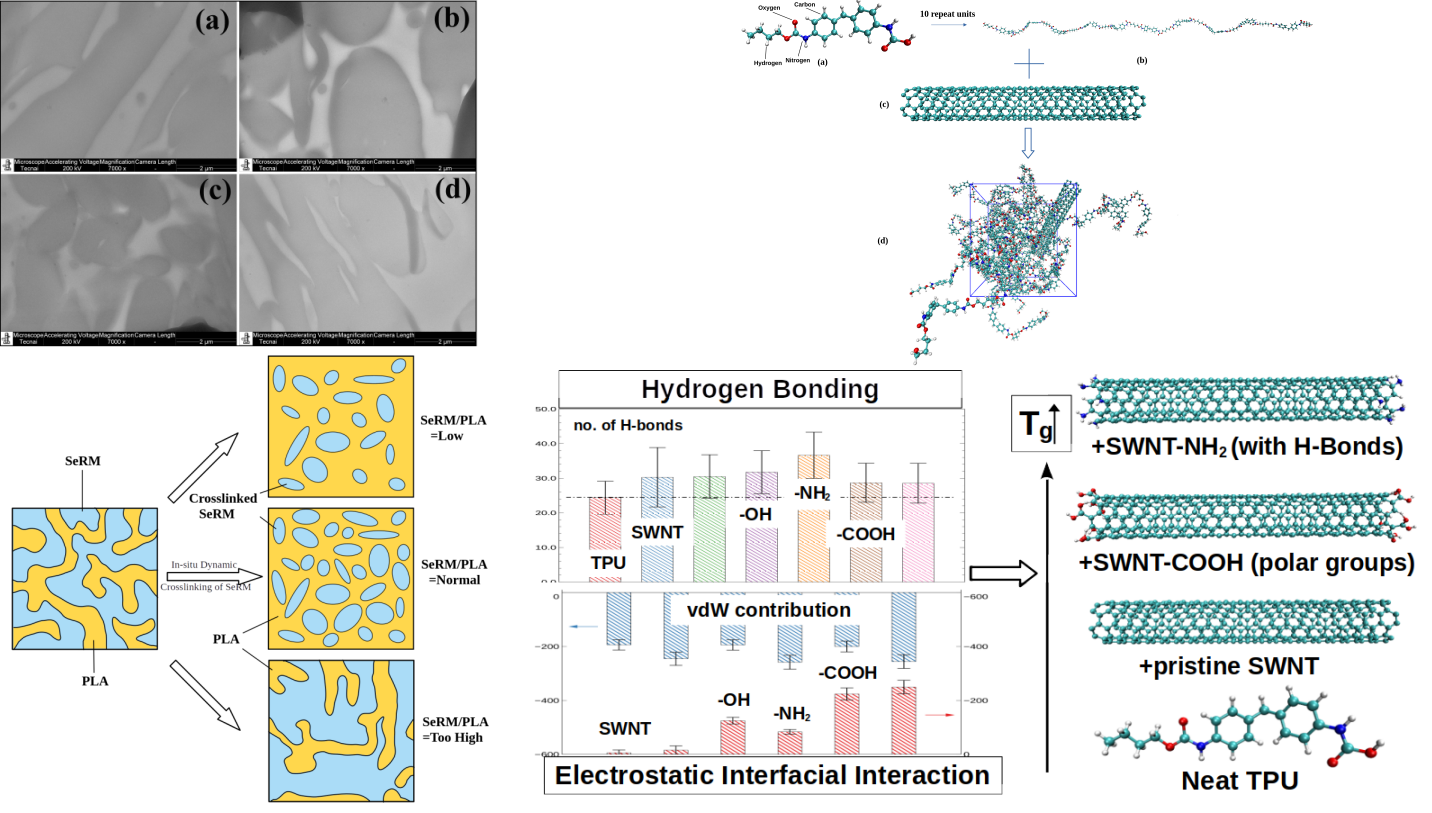Research
Nanoparticle Dispersion in Polymer Matrix
Polymer nanocomposites offer a variety of substantially enhanced properties relative to pure polymer materials. A significant challenge to fully realize the potential of polymer nanocomposites is to rationally control the spatial organization of the incorpated nanofillers due to the complex interplay of enthalpic and entropic interactions leading to filler aggregation and phase separation at various length scales. A promising strategy for desirable nanofiller dispersion is to graft polymer chains onto the nanofillers for tuning the interaction between nanofillers and polymer matrix. We use coarse-grained molecular dynamics simulations to investigate how the dispersion behavior of nanofillers and the chain characteristics are affected by the graft density, graft chain length, garft locations, etc., to elucidate the dispersion mechanism of grafted nanoparticles in polymer matrix. Results indicate that there exists an optimum graft density for the nanoparticle dispersion. The transition from a “wet” to “dry” brush can be observed at the strong brush/matrix interaction.  Recent publications include:
Recent publications include:
- X. Li, J. Shen, et al., Polymer, 211, 123077 (2020). Link
- J. Shen, et al., Macromolecules, 50(2), 687-699 (2017). Link
- J. Shen, et al., Langmuir, 27(24), 15213-15222 (2011). Link
Polymer Network
Chemically crosslinked polymer networks have been enormously fruitful in industrial applications, e.g., the manufacturing of the automobile tires, coatings, adhesives, and membranes. To describe the rubbery elasticity of crosslinked polymers, different theoretical models have been developed regarding the structure and dynamics of polymer networks, including the celebrated affine model, phantom model, tube model theory, and many other nonaffine network models. In the framework of most theoretical models, the mechanical properties are considered to be strongly influenced by the microscopic network structural imperfections, which actually are inherent in network topology and can arise from the initial ends and the loop formation. Using coarse-grained MD simulations, we perform a systematic investigation into the relationship between the structure and properties of polymer networks. From a detailed statistical analysis of the network structures, not only the characteristic network parameters, including the elastically active strands and crosslink junctions and the cycle rank, are determined but also the topological defects, including the dangling loops and the dangling chain ends, are quantified. Results indicate that the time−temperature superposition principle holds on the segmental length scale but fails on the chain length scale, where it can be valid at sufficiently high temperature above the critical temperature.  Recent publications include:
Recent publications include:
- J. Shen, et al., Macromolecules, 52(1), 121-134 (2019). Link
Nonlinear Viscoelastic Behavior
An understanding of the structure−property relationship in polymer nanocomposites is of fundamental importance in designing and fabricating polymer nanocomposites with desired properties. For filler-reinforced polymer nanocomposites, an important feature is the nonlinear mechanical behavior and the resulting Payne effect. When subjected to small deformations, the elastic modulus has been observed to drop significantly, and the resulting decrease (relative to the original modulus) is quantified as the Payne effect, a typical nonlinear viscoelastic behavior. The Payne effect is of fundamental importance in applications such as the rolling resistance and the durability of rubbers. The underlying mechanism of the Payne effect remains unclear. In order to unravel its intricate workings, we have implemented non-equilibrium molecular dynamics simulation to execute oscillatory shear deformation upon polymer nanocomposites, using the SLLOD equations of motion and the Lees–Edwards “sliding brick” boundary conditions. Results indicate that the dominant factor contributing to the Payne effect can be primarily attributed to the breakup of filler network/clusters via direct contacting or via long-range bridging of bound polymer shell (restricted polymer segments surrounding nanofillers).  Recent publications include:
Recent publications include:
- J. Shen, et al., Macromolecules, 51(7), 2641–2652 (2018). Link
- J. Shen, et al., Phys. Chem. Chem. Phys., 17(11), 7196-7207 (2017). Link
- J. Shen, et al., Soft Matter, 10(28), 5099-5133 (2014). Link
Mechanical Reinforcement of Elastomers
Nanosized carbon black or silica is necessarily used in rubber tires for the improvement of various properties, especially the mechanical properties. In principle, the mechanical reinforcement, in terms of the stress–strain behavior as an example, is primarily influenced by the filler properties (size, shape, concentration, surface activity, etc.) and the filler–polymer incorporation aspects (spatial distribution, interfacial compatibility, etc.). However, because of the complex influencing factors and the complicated correlations between them, the microscopic reinforcing mechanism is still not fully understood. Our work provides a deeper insight into the reinforcement mechanism of elastomers by analyzing the stress–strain behavior and the strain-induced nonlinear behavior of the elastic modulus. Non-equilibrium molecular dynamics simulations are carried out to realize the uniaxial tensile deformations. We propose a modified stress–strain equation to better describe the stress-strain behavior of filler-reinforced polymers. Results indicate that the Young’s modulus as a function of the nanoparticle volume fraction greatly exceeds that predicted by the Einstein–Smallwood model and Guth–Gold model, which arises primarily from the contribution of the local/global filler network.  Recent publications include:
Recent publications include:
- J. Shen, et al., Phys. Chem. Chem. Phys., 22(7), 16760-16771 (2020). Link
- J. Shen, et al., Macromolecules, 51(7), 2641–2652 (2018). Link
- J. Shen, et al., Phys. Chem. Chem. Phys., 17(11), 7196-7207 (2017). Link
Thermoplastic Elastomers
Thermoplastic Elastomers (TPEs), composed of both thermoplastic and elastomeric properties, offer unique advantages over conventional elastomers. Unlike thermoset elastomers, TPEs are thermoplastics that are easy to use in manufacturing processes such as injection moulding due to their ability to stretch and return to their near original shape. This creates a longer life and improved physical range when compared to other materials. Due to their two-component injection molding abilities, TPEs are used as soft grip surfaces, design elements, back-lit switches and surfaces, as well as sealings, gaskets, and damping elements. TPEs have the potential to be recycled similarly to plastics, leading to further environmental benefits. We have developed a novel bio-based thermoplastic vulcanizate (TPV) material consisting of poly(lactic acid) (PLA) and a novel polymeric slide ring material (SeRM) using isocyanate-induced dynamic vulcanization.  Recent publications include:
Recent publications include:
